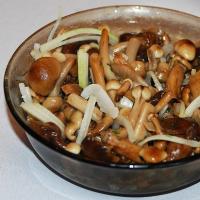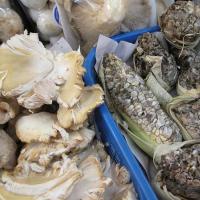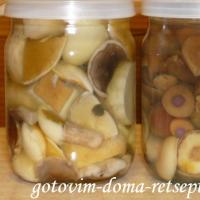Mushrooms poisonous fly agaric: species with photos
Poisonous fly agaric is very dangerous for human health. Different species of fly agaric have varying percentages of muscarines and other types of poisons. The poisonous fly agaric mushroom can give an immediate reaction and long-term effects. Its toxic substances can accumulate in the human body. This page deals with poisonous fly agarics, which are most often found in forests. Look at the poisonous fly agaric in the photo, which demonstrate the appearance of the mushroom.
Fly agaric rough
Cap 6-9 cm in diameter, thick-fleshy, initially spherical, convex, then convex-prostrate and finally flat, with a blunt smooth edge, olive, grayish-yellowish, grayish-brown, covered with small conical-pointed or flaky, dirty white or yellowish warts. The plates are whitish, becoming grayish-yellowish with time, free, sometimes slightly adherent with a tooth, wide, lanceolate, often with a finely serrated edge. Leg 4-8 x 1.5-2 cm, central, tapering upwards, evenly widened towards the base, with a slightly pointed end, white at the plates, below brownish-yellowish, scaly, with yellowish flakes on the surface, dense, becomes hollow with time . The ring is located in the middle part of the stem, softly hanging, white, striped, with yellowish flakes along the edge. Volva is weakly expressed, dirty-yellow, loose, adheres tightly to the tuberous base of the stem and forms a concentric border. The flesh is white, yellowish or brownish under the skin, soft, with a mild taste and no particular smell. Spore powder is white.
Rough fly agaric forms an association with European beech (Fagus sylvatica L.), common hornbeam (Carpinus betulus L.), oak (Quercus L.), birch (Betula L.). It grows in deciduous and mixed forests, occurs in August - September. Inedible.
Fly agaric
Cap 4-7 (10) cm in diameter, thick-fleshy, at first semicircular, then flat-convex, depressed in the center, with a blunt, flat, smooth edge, white at first, then turning yellow, grayish-yellow, yellowish-greenish, may fade to off-white, covered with whitish patchwork-like remnants of the common veil. The plates are whitish, sometimes with a yellowish edge, free, narrow, frequent, soft. Leg 5-10 x 0.8-2 cm, cylindrical, bulbous-swollen at the base, white or light yellow, solid, then hollow. The ring is located in the upper part of the stem, wide, softly hanging, at first white, then yellowish, expanded below, sometimes slightly striped. Volvo fused with the base of the stem, in the upper part with a free expanded edge, light yellowish, dirty whitish. The flesh is white, yellowish under the skin, soft, with the smell of raw potatoes. Spore powder is white.
It grows in various types of forests, occurs in August - September. Poisonous.
Fly agaric yellow (bright yellow)
Hat 3-7 (11) cm in diameter, initially convex-prostrate, then becomes flat-convex, with a thin short-ribbed edge, from lemon to amber-yellow, sometimes ocher in the center, less often with a reddish tinge, turning pale over time, glutinous, covered with several large white flaps, which, as a rule, are washed off. The plates are white, in old specimens they are pale yellow, free, frequent, thin, wide, soft.
Leg 5-8 (15) x 0.8-1.5 cm, cylindrical, oval-club-shaped at the base, whitish or yellowish, glabrous or with a flaky, appressed coating, similar to a moire pattern, filled in young and hollow in mature specimens. The ring is located in the lower part of the stem, in the form of a white cuff, narrow, drooping, quickly disappearing in the process of growth. Volvo grown, slightly bent along the edge.
The flesh is white, under the skin and at the base of the stem is yellowish, with a mild taste, with a slight rare smell. Spore powder is white.

Fly agaric yellow (bright yellow) grows mainly in coniferous forests, occurs in August - September. Inedible.
Fly agaric red
 Cap 5-15 (25) cm in diameter, initially spherical, then flat-prostrate to concave, with a slightly ribbed edge, bright red, yellowish-orange-red, weakly sticky, covered with white or slightly yellowish, irregularly rounded, flaky, later disappearing scales. The plates are white, eventually creamy, free, wide, frequent, thick, unequal in length, with an uneven edge.
Cap 5-15 (25) cm in diameter, initially spherical, then flat-prostrate to concave, with a slightly ribbed edge, bright red, yellowish-orange-red, weakly sticky, covered with white or slightly yellowish, irregularly rounded, flaky, later disappearing scales. The plates are white, eventually creamy, free, wide, frequent, thick, unequal in length, with an uneven edge.
Leg 5-10 (25) x 1-1.5 (3) cm, cylindrical, tuberous-swollen at the base, white, dense, filled in young and hollow in mature specimens. The ring is located in the upper part of the stem, white, sometimes yellowish along the edge, wide, striped, can be serrated, hangs softly. Tuberous thickening of the stem with several rows of concentrically arranged white warts, which are the remains of the Volvo.
The flesh is white, slightly yellowish under the skin, with a mild taste and no particular smell. Spore powder is white.
Fly agaric panther
 Cap 4-8 (10) cm in diameter, initially hemispherical, then flat-convex, with a thin ribbed edge, brownish-grayish-yellowish, less often whitish, sticky, with whitish or sand-colored numerous small flaky, scaly warts arranged in circles or evenly over the entire surface. The plates are white, free, frequent, soft, of unequal length, expanded towards the edges and narrowed at the stem.
Cap 4-8 (10) cm in diameter, initially hemispherical, then flat-convex, with a thin ribbed edge, brownish-grayish-yellowish, less often whitish, sticky, with whitish or sand-colored numerous small flaky, scaly warts arranged in circles or evenly over the entire surface. The plates are white, free, frequent, soft, of unequal length, expanded towards the edges and narrowed at the stem.
Leg 4-10 (13) x 0.8-1.5 cm, narrowed at the top, tuberous-swollen at the base, elongated, white, solid, then hollow.
The ring is located in the middle part of the stem, without a jagged edge and folds, white, narrow, thin, quickly disappearing. Volvo fused, but easily separated from the base.
The flesh is white, brownish under the skin, with a sweetish taste and a slight rare smell. Spore powder is white.
It grows in various types of forests, occurs in July - September. Poisonous.
Fly agaric panther smelly
 The cap is 3-8 cm in diameter, initially ovoid, then flat-convex, often with a wide smoothed tubercle, with a thin edge lowered, gray-black, slightly sticky, with many off-white or grayish patches or warts. The plates are white, free, with uneven edges.
The cap is 3-8 cm in diameter, initially ovoid, then flat-convex, often with a wide smoothed tubercle, with a thin edge lowered, gray-black, slightly sticky, with many off-white or grayish patches or warts. The plates are white, free, with uneven edges.
Leg 5-10 x 1-2 cm, cylindrical, noticeably thickened downwards, thick, very hard, flaky-pubescent under the ring, gray or off-white.
The ring is thick and whitish. Volva grown.
The pulp is white, thick, with a fresh taste and a slight rare smell. It turns red under the action of phenol.
Panther fly agaric grows mainly in spruce forests, occurs in July - September. Poisonous.
Pale grebe, fly agaric green
 Cap 5-10 (15) cm in diameter, initially hemispherical, then flat-convex or flat-prostrate, with a smooth even edge, greenish, yellowish-greenish, olive-greenish, gray-green, greenish-white, darker in the center , towards the edge - lighter, fibrous or smooth, with a silky sheen, mucous in wet weather, the skin is easily removed, with rare, easily erasable patches. The plates are white or with a slightly greenish tint, free, frequent, thin.
Cap 5-10 (15) cm in diameter, initially hemispherical, then flat-convex or flat-prostrate, with a smooth even edge, greenish, yellowish-greenish, olive-greenish, gray-green, greenish-white, darker in the center , towards the edge - lighter, fibrous or smooth, with a silky sheen, mucous in wet weather, the skin is easily removed, with rare, easily erasable patches. The plates are white or with a slightly greenish tint, free, frequent, thin.
Leg 5-10 (12) x 0.8-1 (2) cm, elongated with a tuberous-widened base, white, sometimes brown-olive downwards, with a moire pattern from plaque, solid, then hollow. The ring is located in the upper part of the stem, soft, white, hanging, wavy, striped, often with an olive tint on the underside. Volvo is white, bag-shaped, free, with uneven blade-like edge.
The flesh is white, under the skin with its shade, sweetish or with a nutty taste and a smell of dampness. Spore powder is white.
Fly agaric green grows mainly in deciduous and mixed forests, occurs in June - September. Poisonous.
fly agaric porphyry
Cap 3-7 (11) cm in diameter, initially ovate-bell-shaped, then flat-prostrate, with a thin flat smooth edge, dirty brown, with a purple or bluish-violet tint, thinly fleshy, moist, covered with sparse flaky membranous warts . The plates are white, adherent, frequent, thin, soft. Leg 5-10 x 0.8-1.5 cm, cylindrical, tuberiformly expanded downwards, naked, white, with a grayish or purple-gray tint. The ring is located in the middle part of the stem, thin, white, subsequently turning yellow or turning brown on the outside, may disappear with time. Volvo is white or light gray, may turn yellow with age, bag-shaped, free. The flesh is white, under the skin with its shade, with a slight rare taste and the smell of raw potatoes. Spore powder is white.

Amanita porphyry grows in coniferous, especially in damp and fresh pine forests, occurs in July - September. Poisonous.
Fly agaric spring
Cap 4-7 (10) cm in diameter, round-bell-shaped, then convex-prostrate, procumbent, sometimes depressed or with a wide tubercle, with a smooth ribbed edge, smooth, silky in dry weather, white, with an ocher tinge in the center, usually with sparse, easily washable white patches. The plates are white, free, thin, frequent, with plates. Leg 7-10 (12) x 0.7-1.5 (2.5) cm, central, cylindrical, tuberous-swollen at the base, made, then hollow, white, glabrous or with slightly noticeable pressed flocculent coating, fibrous. With an apical, white, wide, silky, delicate ring with a striped edge. Volvo free, bag-shaped, with an uneven edge, white. The pulp is dense, brittle, white, almost odorless, with an unpleasant taste. Spore powder is white.

Amanita muscaria grows in various types of forest, occurs in June - October. Poisonous.
Fly agaric smelly (white)
 Cap 5-7 (10) cm in diameter, initially ovate-campanulate, conical, then bell-shaped or convex, sometimes with a tucked edge, white or ivory, sometimes slightly yellowish towards the top (especially in older specimens), slightly mucous , shiny when dry, usually covered with shreds of veil. The plates are white, free, narrow, frequent, soft, with a finely flaky-pubescent margin.
Cap 5-7 (10) cm in diameter, initially ovate-campanulate, conical, then bell-shaped or convex, sometimes with a tucked edge, white or ivory, sometimes slightly yellowish towards the top (especially in older specimens), slightly mucous , shiny when dry, usually covered with shreds of veil. The plates are white, free, narrow, frequent, soft, with a finely flaky-pubescent margin.
Leg 10-15 (17) x 0.8-1 (2) cm, cylindrical, tuberous-swollen at the base, solid, then hollow, with a flocculent coating. With a white, wide, silky, delicate ring, which very often quickly disappears, sometimes fibrous, ring-shaped belts remain instead. Volvo is bag-shaped, free, deeply immersed in the soil.
The flesh is white, very brittle, with an unpleasant odor and taste. Spore powder is white.
It grows in various types of forests, occurs in June - October. Poisonous.



